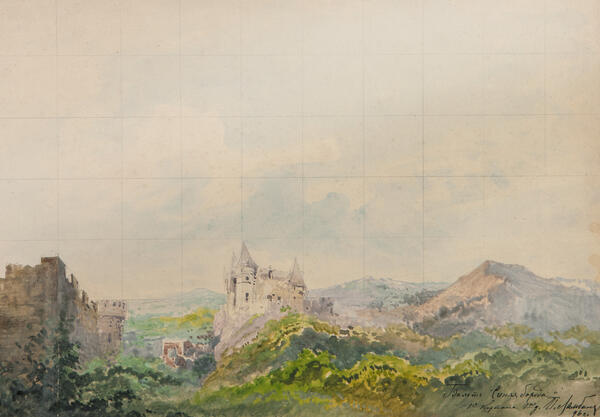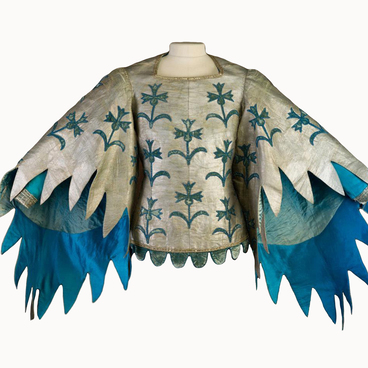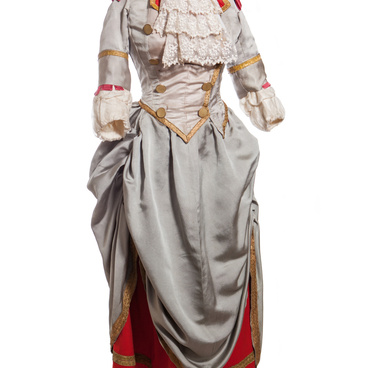The choreographer Alexander Alexeyevich Gorsky (1871–1924) was a younger contemporary of a French-Russian ballet dancer and choreographer Marius Petipa. In 1896, Marius Petipa celebrated the 50th anniversary of his career in the imperial theaters. In honor of this, a benefit event was held at the sold-out Mariinsky Theater — a ballet-féerie called “Bluebeard, ” where the 25-year-old Alexander Gorsky played one of the Gold Vessels. The museum’s collection houses the stage costume that Alexander Gorsky was wearing for that performance. Expensive materials and rich ornaments were intended to highlight the splendor of this garment.Just a few years later, Alexander Gorsky became the main choreographer at the Bolshoi Theater and remained at this post right until his death in 1924. The first ballet that Alexander Gorsky staged was “Don Quixote.” His version was different from the traditional one, for example, it included elements of folk dance. The premiere drew public attention and induced heated discussions.
Alexander Gorsky’s reputation as a reformer would be reinforced by his further projects where he restaged Petipa’s classical ballets — “Don Quixote”, “Swan Lake”, and “Raymonda.” The choreographer engaged young artists Konstantin Korovin and Alexander Golovin to work on the scenery and costumes. This decision marked the new approach to the visual aspect of ballet.
Alexander Gorsky was meticulous in planning every ballet he staged and always did a lot of preparatory work. He strove for verisimilitude of historical details and elements of national identity. When Gorsky was staging the ballet based on the novel by Victor Hugo, this approach led him to take a trip to Paris together with Konstantin Korovin so that they could explore the setting.
Alexander Gorsky’s main goal was to achieve the maximum authenticity of his ballets. Following the principles of Stanislavsky’s aesthetics, the choreographer distributed the parts among all the participants himself, including every figurant and member of the corps de ballet. In each group dance, Gorsky assigned various movements to different groups. The younger members of the troupe approved such changes whole-heartedly.
In the early 20th century, Alexander Gorsky took a liking to the newly emerged trends of Impressionism and Symbolism. It coincided with the staging of the ballet called “Salammbô” based on the novel of the same name by Gustave Flaubert. The critics agreed that it was one of Gorsky’s best achievements as a choreographer.
Alexander Gorsky’s reputation as a reformer would be reinforced by his further projects where he restaged Petipa’s classical ballets — “Don Quixote”, “Swan Lake”, and “Raymonda.” The choreographer engaged young artists Konstantin Korovin and Alexander Golovin to work on the scenery and costumes. This decision marked the new approach to the visual aspect of ballet.
Alexander Gorsky was meticulous in planning every ballet he staged and always did a lot of preparatory work. He strove for verisimilitude of historical details and elements of national identity. When Gorsky was staging the ballet based on the novel by Victor Hugo, this approach led him to take a trip to Paris together with Konstantin Korovin so that they could explore the setting.
Alexander Gorsky’s main goal was to achieve the maximum authenticity of his ballets. Following the principles of Stanislavsky’s aesthetics, the choreographer distributed the parts among all the participants himself, including every figurant and member of the corps de ballet. In each group dance, Gorsky assigned various movements to different groups. The younger members of the troupe approved such changes whole-heartedly.
In the early 20th century, Alexander Gorsky took a liking to the newly emerged trends of Impressionism and Symbolism. It coincided with the staging of the ballet called “Salammbô” based on the novel of the same name by Gustave Flaubert. The critics agreed that it was one of Gorsky’s best achievements as a choreographer.





